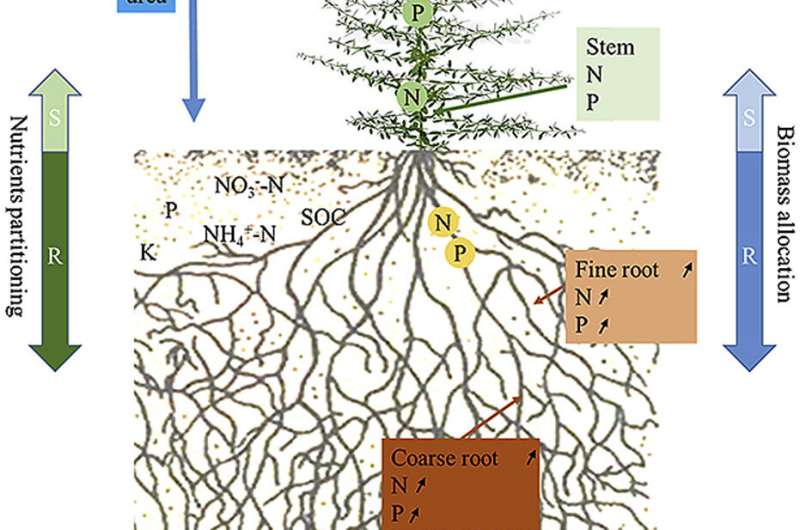Graphical abstract https://doi.org/10.1016/j.plaphy.2020.08.036
Groundwater and its nutrients sustain the deep-rooted phreatophytes. However, how phreatophyte seedlings respond to water and nutrients in topsoil before their roots reach groundwater remains unclear.
Moreover, nitrogen (N) enrichment fertilizes desert ecosystems, while drought limits the movement of soil nutrients. Little attention has been paid to the effects of their interactions on desert deep-rooted plants.
Researchers from the Xinjiang Institute of Ecology and Geography (XIEG) of the Chinese Academy of Sciences systematically studied how the two phreatophyte species seedlings, Alhagi sparsifolia and Calligonum mongolicum dominating in the southern margin of the Taklimakan desert, responded to variations of nitrogen and water by simulating N deposition and water stress.
They found that N and water independently or interactively influenced photosynthesis, drought tolerance, morphological characteristics, and the distribution pattern of biomass and nutrients among organs of the two plants.
The increased N input improved the uptake of N and P by increasing root biomass of A. sparsifolia, thus adapting to drought. For C. mongolicum seedlings, the proper addition of N enhanced the resistance to water stress by improving the water use efficiency, superoxide dismutase, and nitrite reductase activities, in which soluble protein played an important role.
In general, an appropriate amount of N addition can alleviate the drought stress of desert plant seedlings. The response of desert deep-rooted plant seedlings to N enrichment and drought involves the interdependence of aboveground- and underground-part functional traits, and more biomass and nutrients are allocated to thin roots to absorb scarce resources.
These findings are helpful to further understand the water use pathways and nutrient response strategies of desert deep-rooted plant seedlings. They also provide an important scientific basis for the study of vegetation degradation mechanism and restoration technology in arid areas and the optimal management of desert ecosystems under the scenario of global climate change.
The studies were published in Plant Physiology and Biochemistry and Plant Biology, respectively.
More information: Z. Zhang et al. Involvement of soluble proteins in growth and metabolic adjustments of drought‐stressed Calligonum mongolicum seedlings under nitrogen addition, Plant Biology (2020). DOI: 10.1111/plb.13190
Zhihao Zhang et al. Nitrogen application mitigates drought-induced metabolic changes in Alhagi sparsifolia seedlings by regulating nutrient and biomass allocation patterns, Plant Physiology and Biochemistry (2020). DOI: 10.1016/j.plaphy.2020.08.036
Provided by Chinese Academy of Sciences























